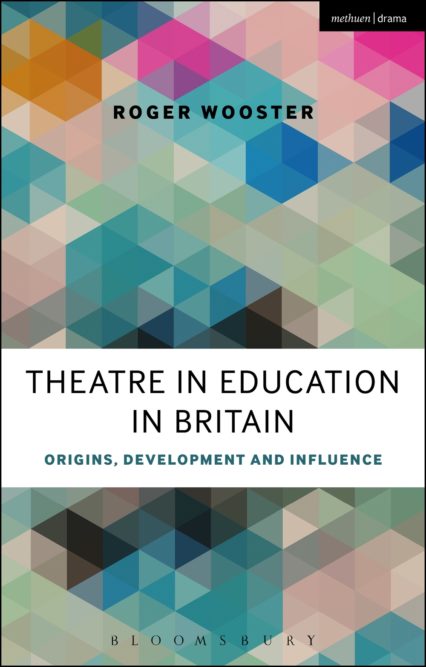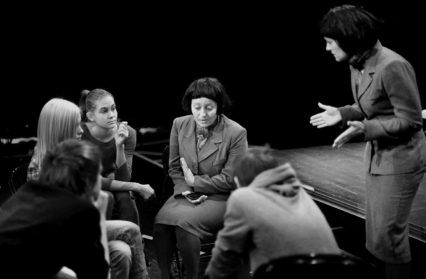Phil Morris reviews Theatre in Education in Britain: Origins, Development & Influence by Roger Wooster.
 It’s the early 1980s, theatre-maker Ian Yeoman proposes to devise a play examining the civil wars in Central America for Theatre in Education company M6. His colleague David Pammenter argues instead for creating a piece exploring the IRA hunger strikes. Both proposals are presented to the company, members debate their respective merits and a vote is taken – the hunger strikes project wins out. This somewhat obscure episode is recounted briefly by Roger Wooster in Theatre in Education in Britain: Origins, Development and Influence, in a chapter concerning the democratic working processes of TIE companies. In microcosm, it illustrates the defining features of Theatre in Education (TIE) outlined in Wooster’s timely and valuable book, namely: global political concerns, radical thinking – in terms of creativity, teaching and working practices – and an utter confidence in the capacity of children to explore complex issues through the medium of theatre.
It’s the early 1980s, theatre-maker Ian Yeoman proposes to devise a play examining the civil wars in Central America for Theatre in Education company M6. His colleague David Pammenter argues instead for creating a piece exploring the IRA hunger strikes. Both proposals are presented to the company, members debate their respective merits and a vote is taken – the hunger strikes project wins out. This somewhat obscure episode is recounted briefly by Roger Wooster in Theatre in Education in Britain: Origins, Development and Influence, in a chapter concerning the democratic working processes of TIE companies. In microcosm, it illustrates the defining features of Theatre in Education (TIE) outlined in Wooster’s timely and valuable book, namely: global political concerns, radical thinking – in terms of creativity, teaching and working practices – and an utter confidence in the capacity of children to explore complex issues through the medium of theatre.
Theatre Education in Britain is an authoritative historical survey of an important, yet often underappreciated and sometimes derided field of theatre-making. TIE ambitiously fuses the provocative aesthetics of agit-prop with innovative child-centred pedagogy to produce a theatre that is wholly directed to affecting social change via the personal development of the individual child. As such, the book serves as a warning of what might be lost to the increasing commodification of education, following the destructive effects wrought by the Education Reform Act of 1988 and the ceaseless meddling in schools by successive governments ever since. In the first section of Wooster’s three-part narrative he traces the roots of TIE, from the educational theories of Harriet Finlay-Johnson and Henry Caldwell Cook in the early twentieth century to the ideas of Jean-Jacques Rousseau. In The Social Contract Rousseau advocates for a learner-centred approach to education as opposed to a teacher-centred model of knowledge transmission. Rousseau asserts that a child is able to solve problems put before them solely by the heuristic process of their own faculties of reason: “Let him know nothing because you have told him, but because he has learnt it for himself.”
The potential of theatre as an agent for social change was perhaps grasped most firmly by the Bolsheviks during and after the 1917 revolution. The propaganda machinery of the Communist Party deployed theatre troupes across the Soviet Union to politically educate its mostly illiterate masses. Theatre’s capacity to empower people to discern and critique the politico-economic forces that oppress them, however, reached the height of its sophistication and creative powers in the drama of Bertholt Brecht and his collaborators. Wooster delineates with impressive lucidity how TIE developed from these traditions of progressive education theory and radical political activism within the context of the wider social upheavals resulting from both World Wars.
A major strength of Theatre in Education in Britain is its detailed and informed contextualising of TIE within the social history of the nation throughout the twentieth century. Wooster points out that the growth of TIE during the post-war period is largely attributable to two factors; a “state-subsidized regional repertory theatre system across the UK” and Local Authorities that were able to financially support “peripatetic groups of trained artist-educators”. The book’s mid-section examines the flourishing of TIE as an emergent theatre form and agile educative methodology. The work of early TIE companies, notably the pioneering work created under the aegis of the Belgrade Theatre in Coventry, was made possible through cooperation between mainstream theatre artists, local government and schools – even though some teachers might not have been fully cognisant of the radical nature of TIE’s socio-political critique.
Wooster’s prose, though commendably clear and gratifyingly jargon-free, is soberly academic in tone, and yet his story is one of a bold adventure in educational empowerment. While his intended readership appears to be largely fellow theatre practitioners and professional educators, even casual readers will be fascinated by the case-studies Wooster provides of challenging and complex TIE projects created for audiences of pre-teen children. In Careless Talk – devised and first performed by Theatr Powys in 1986 – the experiences of a Welsh farming family during World War II were not used simply to teach children about how life was lived ‘back in the olden days’, they became a provocation to explorations of the larger themes of patriotism, fascism, racism, bullying and bereavement. In Wooster’s view, Careless Talk was especially effective because of its experiential elements. In best practice TIE, the child is not a passive observer, she is an active participant in the process of making meaning and, in some cases, constructing or directing the action. In a later section of the book, Wooster quotes playwright and theorist Edward Bond (who has worked with TIE stalwart Big Brum since the mid-nineties) explaining how the participatory involvement of children within a work of theatre empowers them with the thought “we are making it happen and it is happening to us.”
Such case-studies provide Theatre in Education in Britain with a palpable sense of excitement for what TIE was and remains capable of achieving in terms of enabling children to become critical thinkers and collaborative problem-solvers. It is a bitter irony of Wooster’s book that just as our emergent information economy requires a workforce that can think both reflectively and creatively, recent governments have effectively defunded TIE companies and favoured regressive educational policies designed for an industrial age that is passing into history. Wooster warns against advocating for TIE based on economic arguments – as if the role of education is merely to provide willing worker-consumers to sustain the capitalist system – yet it is curious that a pedagogical method designed to empower children to think for themselves is struggling for its existence at a time when money is being found by the current government to re-establish grammar schools. Wooster offers a possible reason for this apparent short-sightedness: “UK governments had never understood the nature of TIE except perhaps to be aware that it tended to raise awkward political questions.”
Theatre in Education in Britain will prove to be an invaluable resource for those studying the field for years to come, principally because of the inherent problems with archiving its repertory. As Wooster acknowledges, “the publication of scripts is often not reflective of the actual experience of the children” on the day of performance and “filming of projects was prohibitively expensive and little has survived”. Moreover, the book also serves as a robust corrective to widespread misconceptions about TIE, namely that it’s simply about ‘putting plays on in schools’ or that it lacks aesthetic quality or pedagogical rigour. (Such misconceptions were mercilessly exemplified by The League of Gentlemen in their savagely funny Legz Akimbo sketches).
Wooster’s opportune history makes clear that, at its best, TIE is not only artistically challenging but also motivated and underpinned by the profound ideas of a number of social and pedagogical theorists including, among others; Dorothy Heathcote, Lev Vygostsky, Paulo Freire and Augusto Boal. The book concludes with the sense that while it can justifiably claim to have influenced a whole range of Applied Drama contexts, such as Theatre in Health Education, Prison Theatre and Drama Therapy, TIE now faces an existential crisis. With many TIE companies, including Theatr Powys, being defunded out of existence, others have adapted their content and delivery to offer a ‘banking model’ of teaching (Freire’s term for traditional knowledge transmission) that can be directly applied to specific aspects of the National Curriculum, particularly its Personal, Social, Health and Citizenship Education component. Wooster argues that, in some cases, “TIE praxis has become debased by its separation from theory and in many cases has become a sugar-coated ‘message-pill’ that could be as easily delivered by formal teaching or video”.
School league-tables attest to how proficient our local GCSE and A-Level factories are at preparing our children for tests, but how does one tabulate the profound realisation by a child that the Second World War was waged against Nazism, and that the fight against its racist ideology continues up to our present moment? A work of theatre, especially one that engages the active participation and reflective analysis of children, can engender an imaginative empathy that enables them to connect the bullying they witness or experience in the playground to racial abuse as it is manifested throughout society, which they might then link to the historical conflicts between democracy and fascism. This making of connections is the starting point of what Betty Giannouli and David Pammenter term “a dialogical construction of meaning of those growing into their world”.
Wooster chronicles with intellectual rigour and insight, the origins and development of a movement whose achievements in primary and secondary education has too-often been ignored or devalued; though perhaps his book’s chief importance lies in the note of caution that is sounded frequently throughout its final chapters. While Wooster acknowledges that there remain dedicated TIE companies whose work lives up to the very best of previous decades, he concludes ominously that there is “a fearful possibility that much contemporary ‘TIE’, serving the ‘banking model’ of education, is itself anticipating the future inflexibility of education and politics.” There is a real danger therefore, that in terms of educating children we will take the measure of everything yet know the value of nothing.
Theatre in Education in Britain
Roger Wooster was a founder member of Open Cast Theatre in Swansea before he joined Theatr Powys, where he was part of a team that developed highly regarded participatory praxis influenced by the ideas of Dorothy Heathcote. He later moved into academia, setting up the Performing Arts programme in Newtown and then lecturing at the University of Wales, Newport (now the University of South Wales) in Performing Arts and Applied Drama. Now retired, he continues to contribute to journals and international conferences.
You can purchase a copy of Theatre in Education in Britain: Origins Development & Influence by clicking here.
Theatre in Education in Britain












